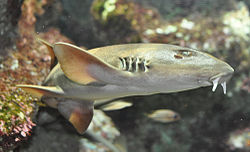| Hemiscylliidae Temporal range: | |
|---|---|
 | |
| Grey bamboo shark (Chiloscyllium griseum) | |
| Scientific classification | |
| Kingdom: | Animalia |
| Phylum: | Chordata |
| Class: | Chondrichthyes |
| Subclass: | Elasmobranchii |
| Division: | Selachii |
| Order: | Orectolobiformes |
| Family: | Hemiscylliidae T. N. Gill, 1862 |
The Hemiscylliidae are a family of sharks in the order Orectolobiformes, commonly known as longtail carpet sharks and sometimes bamboo sharks. They are found in shallow waters of the tropical Indo-Pacific.
Contents
They are relatively small sharks, with the largest species reaching no more than 121 cm (48 in) in adult body length. They have elongated, cylindrical bodies, with short barbels and large spiracles. As their common name suggests, they have unusually long tails, which exceed the length of the rest of their bodies. They are sluggish fish, feeding on bottom-dwelling invertebrates and smaller fish. Bamboo sharks make noises such as popping and sucking when feeding, clicking jaws when handled as a stress signal and hissing by expelling water from their gills. [1]
